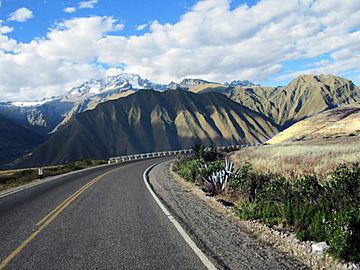Ancasmarca facts for kids
Quick facts for kids Ancasmarca |
|
|---|---|
| Pitusiray / Sallcasa | |

The Urubamba mountain range as seen from the southwest. Chicón is on the left. Huamanchoque and Ancasmarca are visible on the right side in the background of this image.
|
|
| Highest point | |
| Elevation | 5,198 m (17,054 ft) |
| Geography | |
| Location | Peru, Cusco Region |
| Parent range | Andes, Urubamba |
Ancasmarca, also known as Pitusiray or Sallcasa, is a very tall mountain in the Andes mountains of Peru. It stands 5,198-metre-high (17,054 ft)! This mountain is part of the Urubamba mountain range.
You can find Ancasmarca in the Cusco Region of Peru. It's located in the Calca Province, near the Vilcanota River. The mountain is surrounded by other peaks like Huamanchoque and Sahuasiray.
Ancient Stories of Ancasmarca
Long ago, around the year 1575, a Spanish writer named Cristòbal de Molina wrote down some amazing stories about Ancasmarca. These stories were part of the Inca people's beliefs.
The Great Flood Myth
One of the most famous stories tells about a shepherd and a great flood.
- The shepherd had a special connection with his llamas.
- His llamas seemed sad because the stars were very high in the sky.
- The animals somehow knew that a huge flood was coming.
- The shepherd listened to his llamas and understood the danger.
To escape the rising waters, the shepherd took his six children to the top of Ancasmarca hill. As the water rose higher and higher, the hill itself also grew taller! This kept them safe from the flood. Once the water went down, the shepherd's children helped to repopulate the area.
For Molina, this story was similar to the great flood stories found in other cultures, like the one about Noah in the Bible. It showed how ancient people tried to explain big natural events.
What Does "Ancasmarca" Mean?
The name "Ancasmarca" comes from the Quechua language, which was spoken by the Inca people. It can have a couple of interesting meanings:
- "Blue Village": If you combine Anqas or ancash (meaning "blue") with marka (meaning "village"), you get "blue village."
- "Eagle Village": Another meaning comes from Anca (meaning "eagle") and marka (meaning "village"). This would mean "village inhabited by eagles."
Both names give us a cool idea of what the area might have looked like or what was important to the people who lived there.


